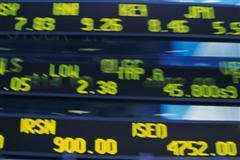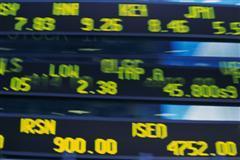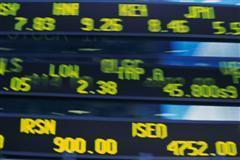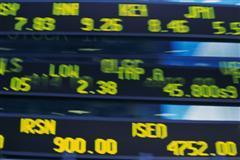| Home | About | Archives | RSS Feed |

@theMarket: Third-Quarter Earnings Reveal Two Economies
 With one quarter of the companies in the S&P 500 already reporting, third quarter earnings have been a positive surprise. Eighty-six percent have exceeded earnings estimates and 67 percent have posted higher revenue numbers. What the numbers don't say is that most of those gains have come from overseas.
With one quarter of the companies in the S&P 500 already reporting, third quarter earnings have been a positive surprise. Eighty-six percent have exceeded earnings estimates and 67 percent have posted higher revenue numbers. What the numbers don't say is that most of those gains have come from overseas.
The revenue number is where we should focus our attention. Higher earnings can be achieved by simply continuing to cut costs (by firing workers, for example). However, looking at the revenue numbers gives us a clear understanding of where the growth is coming from. Not much of it is coming from the home front. A lot of that growth is coming from higher sales in Asia and other emerging markets.
Since the bottom of the recent recession here in America, the majority of firms in the S&P 500 have been exporting their way into profitability. This quarter was no different. Take United Parcel Services; it is one of the companies that investors consider a good barometer of the global economy because it delivers products everywhere. UPS showed a 3.5 percent increase in growth versus last year here at home while their international growth was 13.7 percent. Many other companies are experiencing the same phenomenon.
Clearly, the falling dollar has helped exports as has the increasing strength in emerging market economies, particularly in Asia. And this weekend all eyes will be focused on the latest round of G20 talks in Seoul, where the ongoing battle to "beggar they neighbor" will continue. We can expect currencies to be one of the main topics of conversation since our own U.S. Treasury Secretary Tim Geithner has already fired the first broadside. In an open letter he has asked members to "refrain from exchange rate policies designed to achieve competitive advantage by either weakening their currency or preventing appreciation of undervalued currency."
In last week's column, "The Coming Currency War," I explained how the world's governments are using their currencies to increase exports at the expense of their neighbors. Clearly, U.S. third-quarter earnings underscore how our own policies have aided and abetted U.S. companies in exporting more. This makes Secretary Geithner's request look a bit suspect in my opinion. It will be interesting to see the response of other governments.
I mentioned last week that I was waiting for commodities, specifically gold and silver, to pull back. I expected that pullback to be sharp, and it has been. After hitting a high of $1,380 an ounce, gold dropped as low as $1,317 an ounce in what felt like a blink of the eye. Silver also had a commensurate move downward. As expected, a rise in the dollar was the catalyst for that pullback. Traders will wait until they see the results of this weekend's G20 meet before going back into precious metals or other commodities.
There is always the risk that some new policy initiative could strengthen the dollar and thus continue the commodity sell-off. It could happen, but I wouldn't hold my breath. There are few new policy alternatives on the table in Washington to revive the economy so my bet is that after a brief period of strength, the dollar will resume its decline, gold and other commodities will continue higher and so will the stock market. Under that scenario, we are back to buying the dips. Invest accordingly.
| Tags: currency, global economy, dollar |
@theMarket: QE II Supports the Markets
 No, QE II is not the name of a cruise ship; although it might as well be, given the upward ride it is providing the stock market. The Federal Reserve is expected to launch another quantitative stimulus effort in early November and the markets are rising in anticipation of that event.
No, QE II is not the name of a cruise ship; although it might as well be, given the upward ride it is providing the stock market. The Federal Reserve is expected to launch another quantitative stimulus effort in early November and the markets are rising in anticipation of that event.
On Friday, Fed Chairman Ben Bernanke reiterated that the central bank is ready to move if necessary to stimulate the economy. Investors are assuming it's a question of "when" and not "if" the Fed will move to buy additional U.S. Treasury bonds, mortgage-backed securities and whatever else they decide will provide additional impetus to a slow-growth economy.
In an election year, where the continuing high rate of unemployment and the ongoing housing mess is being blamed on the Democrats, the pressure on the Fed for a QE II must be enormous. Remember, at the end of the day, Bernanke is a political appointee, as are the members of the Fed's governing board. Sure, we would like to think that the Fed is an independent body focused solely on the economic health of America and it is most of the time.
On the other hand, if the president's wishes dovetail with what the Fed perceives to be necessary in helping the economy so much the better.
In my last few market columns, I explained that QE II was a game changer. The Fed, by promising additional stimulus, is providing investors with a "put" on the economy and therefore on the stock market. If the economy continues to grow on its own, the markets will go higher. If the economy falters, the Fed will intervene to fix it and the markets will go higher. What's not to like about that?
The arguments on whether we really do need another stimulus, will QE II really work, and will it add to the potential for more inflation down the road are consuming a forest of newsprint. In the meantime, investors are dumping the dollar (see my latest column "The Coming Currency Wars"), the markets forge steadily higher and commodities of all kinds are on fire.
As readers recall, only a month ago I raised my price target for gold to $1,350 per ounce. We have already surpassed that level and it looks like the yellow metal will hit $1,400 per ounce very soon. I'm going to have to raise my price target again but first I would like to see gold and other commodities pull back.
The dollar is key to any commodity correction. There is an inverse relationship between the dollar and commodities. The dollar may bounce over the next few weeks and if it does, that should cause commodities in general to pull back. Remember too that in the commodity arena, corrections are extremely sharp where prices can drop dramatically in a very short time.
As the S&P 500 Index flirts with the 1,180 level, I would expect a bit of resistance before the bulls make a dash toward the year's highs. The ongoing questions over housing foreclosures that have embroiled most of the banking sector this week has kept a lid on the averages. The next Fed meeting won't be until early November so any potential QEII is still weeks away. The main market moving catalyst we face is this quarter's earnings announcements. So far, company results have been a mixed bag. My advice is to let the markets pull back a bit before committing any more money to this party.
| Tags: Federal Reserve, Bernanke, stimulus |
@theMarket: A September to Remember
 It was a strong September, the best in 70 years, with the Dow up more than 8 percent for the month while the other averages were not far behind. As the third quarter closes, however, the clear winners were precious metals. But it appears that both commodities and stocks have more to run in the weeks ahead.
It was a strong September, the best in 70 years, with the Dow up more than 8 percent for the month while the other averages were not far behind. As the third quarter closes, however, the clear winners were precious metals. But it appears that both commodities and stocks have more to run in the weeks ahead.
At the close of the week, we had a bit of profit taking in stocks as well as commodities, but that was to be expected. As long as the economic numbers continue to come in better than expected, the data will provide support for further upside in these markets.
This week most of that data surprised analysts. Second-quarter GDP growth rate came in at 1.7 percent versus an expected 1.6 percent and was 3.7 percent in the first quarter. The core PCE price index gained 1 percent versus 1.2 percent expected. Consumer spending gained 2.2 percent versus a prior gain of 1.9 percent. The New York "ISM" Index of business was 58.3% while analysts expected 55.6 percent and the initial jobless claims were down by 16,000 to 453,000, which were also better than expected.
Numbers like these cheer investors and help justify why the stock markets are climbing after four months of range-bound trading. I believe that markets can correct in two ways: a sharp, painful decline or a period of consolidation where stocks trade in a range until all the sellers have sold. Given the historical run-up in stocks from March 2009 through April 2010, I had warned investors that a correction was due and a period of marking time should also occur while the economy played catch-up with the gains in the markets. I believe that is exactly what has happened over the last five months.
The 1,150 level on the S&P 500 Index has proven stubborn resistance this week. Every time the bulls assaulted that line in the sand, the bears fought back, driving stocks lower again, but not by much and that is what gives me confidence that the bulls will break through that level at some point
Over in the commodity corner, gold has powered higher hitting its 11th record high in a month, trading at $1,316 an ounce before falling back to regroup. Silver has had an even more spectacular run and traded above $22 an ounce before also falling back. Clearly investors are "buying the dips" in those markets. I agree with that strategy. Buyers beware, however, because all that "feel good" emotion as precious metals hit new highs can quickly turn to fear and panic when (not if) commodities correct. These puppies have had quite a run, so new buyers would be advised to wait for the inevitable sharp but short pullback before buying.
As for the stock market, if we punch through 1,150, the next resistance area for the S&P 500 is around 1,180. Notice, too, that at that level we will have almost re-traced all the losses incurred since the market's April high.
One final note, I won't be writing a column next week since I'm going to Maine for a week of kayaking and hiking with my wife and our dog Titus. I'll miss you.
| Tags: metals, quarter, growth, correction |
@theMarket: The Line in the Sand
 It would seem that a low-volume battle is being fought over that 1,130-1,150 level on the S&P 500. As I expected, the break above 1,130 occurred this week and now the bulls have to defend it while attempting to push up above 1,150.
It would seem that a low-volume battle is being fought over that 1,130-1,150 level on the S&P 500. As I expected, the break above 1,130 occurred this week and now the bulls have to defend it while attempting to push up above 1,150.
Actually, the S&P reached an intra-day high of 1148 this week. That is the highest level since May 18. Readers may recall that the present correction and subsequent trading range in the markets began with a decline in late April from a high of 1,219. Last week, I wrote that the S&P 500 would break above this trading range.
Also last week I raised my price targets on gold (to $1,350 per ounce) and silver ($36 per ounce) as well as other precious metals. If those metals continue to steamroll higher, I may have to bump up my estimates in the weeks ahead. Both metals continued to make new highs after the Federal Reserve on Tuesday said they were ready to increase their quantitative easing measures a second time if the economy continued to slow. Investors obviously are betting that QE II is in the cards because both commodities took off just minutes after the meeting.
"Explain that to me," asked one client over sushi at Shiro's this week.
Quantitative easing, for those who are unfamiliar with the concept, occurs when the Fed buys securities (in this case, Treasury bonds and mortgage-backed securities) in an effort to inject more money (stimulus) into the economy. Of course, more money in the system can mean higher inflation down the road if that money is used to buy goods and services. So far, that has not been the case.
All that money continues to sit on the sidelines, earning next to nothing because the banks and corporations are afraid to spend it. Since market participants discount today's actions into the future, investors are assuming that QEII will happen and, at some point down the road, that money will be spent. That will almost assuredly trigger a higher Inflation rate, so buy gold and silver now in anticipation. Of course, the best laid plans sometime go awry. Since gold and silver, along with other commodities, are generating big returns, most players are buying first and asking whether it's a good move later.
While commodities take center stage, the bulls and the bears stand toe to toe. Between them, is drawn a line in the sand that could determine whether this market rolls over once again and trades down 10 percent, or continues higher, maybe back to the April highs. I'm betting higher for now. What the bears don't understand is that the game has changed. The Fed has basically given investors a "put" on the market. Either the economy continues to grow or the Fed will come in and backstop the economy with QE II.
| Tags: securities, metals, commodities |
@theMarket: Precious Metals Gain While Stocks Mark Time
As investors waited for stocks to make up their mind, gold and silver took off this week. Gold made new highs while silver's price level is higher than at any time since 1980. The question is will stocks follow that lead or fall back as they have the last two times the S&P 500 reached this level.
Up until this week, most people (including myself) were betting the market would roll over for a third time and head back to the lows or make new lows. However, thanks to recent economic data that has shed a more positive light on the health of the economy, bullish sentiment among investors has increased to slightly over 50 percent, the highest reading in two years, according to the American Association of Individual Investors. But before you start jumping up and down just three weeks ago those same fickle investors registered the second largest bearish stance in two years. It just indicates how confused we all are about the future direction of the stock market.
In addition, most of us have a trust issue with this market. According to a recent AP-CNBC poll, nearly 90 percent of investors with less than $50,000 and 75 percent of those with $250,000 to invest, believe the stock market is unfair to the little guy. One indication of that sentiment is the continued light volume. Normally after Labor Day volume increases, but the opposite has occurred. That's another sign that market participants are not willing to be burnt a third time. So far this attempt to break out of this four-month trading range has been skittish at best.
All week the market has inched up and down tentatively extending its reach upwards without actually touching the 1,130 level on the S&P. Even if it breaks that level, there is no guarantee that it won't swoon sometime in October. With this much negative sentiment, the contrarian in me is whispering "what if."
What if the markets confound us all and do break out? I must confess that based on the recent economic data and the market's ability to hold the lows over the past few months, I've decided to give stocks the benefit of the doubt here in the short term. However, I am in the "show me" camp. I won't trust this market until I see volume expand and volatility begin to dampen down.
Regardless of what the market does now, I still want to keep some powder dry (cash) at least into October. Further out, I expect a rebound in stock markets which could last for the next two or three quarters.
This is not rocket science. Historically (since 1900) markets do better after mid-term elections, with the uptrend continuing through the first and second quarter of the following year. Couple that history with a growing probability that the GOP will regain sufficient seats in Washington and you have the ingredients for higher markets in the future.
As readers know, I have never believed in a double-dip recession and I have been expecting the economic numbers to improve as more stimulus money is spent and the economy strengthens. That appears to be happening, which will give some fundamental support to my forecast of the market's expected gains.

